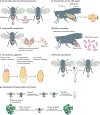Microorganisms in the reproductive tissues of arthropods
- PMID: 31907461
- PMCID: PMC8022352
- DOI: 10.1038/s41579-019-0309-z
Microorganisms in the reproductive tissues of arthropods
Abstract
Microorganisms that reside within or transmit through arthropod reproductive tissues have profound impacts on host reproduction, health and evolution. In this Review, we discuss select principles of the biology of microorganisms in arthropod reproductive tissues, including bacteria, viruses, protists and fungi. We review models of specific symbionts, routes of transmission, and the physiological and evolutionary outcomes for both hosts and microorganisms. We also identify areas in need of continuing research, to answer the fundamental questions that remain in fields within and beyond arthropod-microorganism associations. New opportunities for research in this area will drive a broader understanding of major concepts as well as the biodiversity, mechanisms and translational applications of microorganisms that interact with host reproductive tissues.
Conflict of interest statement
Competing interests statement:
The authors declare no competing interests.
Figures



References
-
- Oulhen N, Schulz BJ & Carrier TJ English translation of Heinrich Anton de Bary’s 1878 speech, ‘Die Erscheinung der Symbiose’ (‘De la symbiose’). Symbiosis 69, 131–139, (2016).
-
- De Bary A Die Erscheinung der Symbiose. Vortrag auf der Versammlung der Naturforscher und Aertze zu Cassel. Trubner, Strasbourg, 21–22 (1879).
-
- Pierantoni U L’origine di alcuni organi d’Icerya purchasi e la simbiosi ereditaria. Boll. Soc. Nat. Napoli 23, 147–150 (1909).
-
- Sapp J Paul Buchner (1886–1978) and hereditary symbiosis in insects. Int. Microbiol 5, 145–150 (2002). - PubMed
Publication types
MeSH terms
Grants and funding
LinkOut - more resources
Full Text Sources

